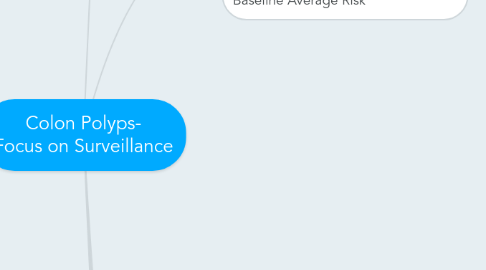
1. Fundamentals
1.1. (prep quality, reached cecum)
1.1.1. , the colon should be cleared of stool and debris to allow for visualization of lesions 5 mm or greater.
1.2. Think about it...
1.2.1. a high risk adenoma (>10mm) and many adenomas (>10) get a shorter surveillance interval than a FHx of first degree relatvie w/ CRC
1.2.1.1. Two HRAs get a 3 year f/u colon. Two HRA's get < 3 year f/u.
1.2.1.1.1. 10m- <10p - >10p -V-HGD
1.2.2. Because the serrated pathway to colon cancer and can move much faster than traditional adenoma carcinoma sequence more frequent and earlier surveillance than adenoma is advised.
1.2.2.1. If your father/mother had SPS you would need a colonoscopy at age 40 (or 10 y before the relative Dx). So SPS is
1.2.3. What is advanced neoplasia
1.2.3.1. Advanced neoplasia is defined as adenoma size >= 10 mm, villous histology or HGD
2. 2012 Recommendations for Surveillance and Screening Intervals in Individuals With Baseline Average Risk
2.1. Hyperplastic Polyps
2.1.1. f/u colon 10 y
2.1.1.1. Recto-sigmoid hyperplastic polyps <=10 mm
2.2. Adenoma Polyps
2.2.1. f/u colon 5 y
2.2.1.1. 1-2 tubular adenomas <=10 mm
2.2.2. f/u colon 3 y
2.2.2.1. 3-10 tubular adenomas
2.2.3. f/u colon <3 y
2.2.3.1. >10 tubular adenomas
2.2.3.1.1. think
2.2.4. High risk polyp
2.2.4.1. f/u colon 3 y
2.2.4.1.1. SIZE: 1 or more tubular adenoma >= 10 mm
2.2.4.1.2. HISTOLOGY: 1 or more villous histology or HGD
2.2.4.2. f/u colon <1 y
2.2.4.2.1. TECHNIQUE: Piecemeal resection
2.3. Serrated Polyps
2.3.1. Serrated polyp
2.3.1.1. f/u colon 5 y
2.3.1.1.1. Sessile serrated polyp(s) (SSP) <= 10 mm
2.3.1.2. f/u colon 3 y
2.3.1.2.1. Sessile serrated polyp(s) (SSP) with dysplasia or SSP >= 10 mm
2.3.1.2.2. Traditional serrated adenoma
2.3.2. Serrated polyposis syndrome
2.3.2.1. f/u colon 1 y
2.3.2.1.1. Defined by any 1 of the 3 criteria
2.3.3. Screening relatives
2.3.3.1. think
2.3.3.1.1. First degree relatives (FDR) of patients with SPS should undergo colonoscopy. Manage them like a FHx of CRC in FDR.
2.3.4. Refs
2.3.4.1. Rex
2.3.4.2. Refs
2.4. Surveillance Intervals
2.4.1. f/u colon 10 y
2.4.1.1. Recto-sigmoid hyperplastic polyps <=10 mm
2.4.2. f/u colon 5 y
2.4.2.1. 1-2 tubular adenomas <=10 mm
2.4.2.2. Sessile serrated polyp(s) (SSP) <= 10 mm
2.4.2.2.1. think
2.4.2.3. Prreviously advanced adenoma, now no polyps
2.4.2.3.1. think
2.4.3. f/u colon 3 y
2.4.3.1. 3-10 tubular adenomas
2.4.3.2. 1 or more tubular adenoma >= 10 mm
2.4.3.3. 1 or more villous histology or HGD
2.4.3.4. Sessile serrated polyp(s) (SSP) with dysplasia or SSP >= 10 mm
2.4.3.4.1. think
2.4.3.5. Traditional serrated adenoma
2.4.3.5.1. The term “serrated adenoma” without a modifier may be misleading and is discouraged, and should be preceded by the terms “traditional” or “sessile”
2.4.4. f/u colon LESS than 3 y
2.4.4.1. >10 tubular adenomas
2.4.4.1.1. think
2.4.5. f/u colon 1 y
2.4.5.1. Serrated polyposis syndrome
2.4.6. f/u colon LESS than 1 y
2.4.6.1. High risk polyp (Villous or adenoma): PLUS Piecemeal resection
2.4.6.1.1. If complete resection is not assured then earlier surveillance needed
3. Post Polypectomy Surveillance: - Average Genetic Risk - Hyperplastic Polyps
3.1. 10 y surveillance
3.1.1. no polyp
3.1.2. <10 mm hyperplastic recto-sigmoid polyp
3.2. ?? need to see what giant hyperplastic polyps get
4. Raf Rizk, MD 01/07/2016
5. References
5.1. Guidelines for colonoscopy surveillance after screening and polypectomy: a consensus update by the US Multi-Society Task Force on Colorectal Cancer.
5.2. American College of Gastroenterology guidelines for colorectal cancer screening 2009
5.2.1. African American average risk : start 45 yo
6. 5 year surveillance intervals for CRC
6.1. Give two patient examples when CRC screening should be performed at five year intervals
6.1.1. patient A: has a first degree relative with CRC
6.1.1.1. continue every 5 y colon
6.1.2. patient B: has a first degree relative with a high risk adenoma occurring before age 60 is followed like a patient w/ FHx of CRC
6.1.2.1. continue every 5 y colon
6.1.2.1.1. What is a high risk adenoma?
6.1.3. patient C: Patient has no family hx. had a previous advanced adenoma then negative exam
6.1.3.1. continue every 5 y colon ???
6.1.4. patient D: Sessile (< 10 mm) non-dysplastic, non-adenomatous serrated polyp(s)
6.1.4.1. continue every 5 y colon
